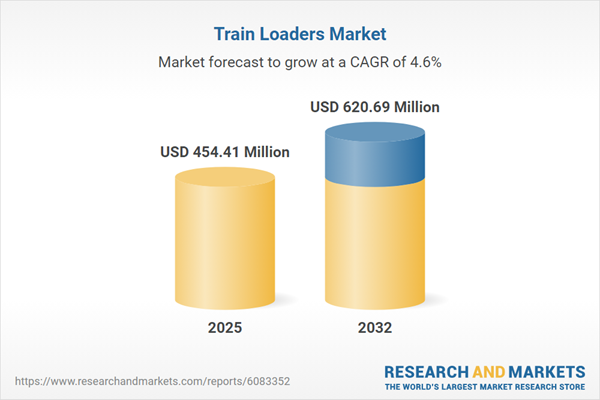Speak directly to the analyst to clarify any post sales queries you may have.
The train loaders market is undergoing significant transformation as digitalization, operational efficiency, and compliance with evolving regulations become central to business strategy. Senior decision-makers are adopting new frameworks to accelerate technology integration and position their organizations for sustainable growth and resilience.
Market Snapshot: Train Loaders Market Insights
The Train Loaders Market advanced from USD 434.76 million in 2024 to USD 454.41 million in 2025 and is set to achieve a compound annual growth rate (CAGR) of 4.55%, reaching USD 620.69 million by 2032.
Scope & Segmentation
This comprehensive report delivers actionable insights tailored for executive leadership, covering market segmentation and key competitive dynamics to support effective strategy alignment in the train loaders market:
- Loader Types: Includes self-propelled models for operational flexibility, stationary systems designed for fixed-site deployment, and train-mounted solutions for seamless rail integration, addressing a broad array of site requirements.
- Power Sources: Diesel engines, electric drives, and hydraulic technologies offer adaptable choices to meet compliance aims and operational standards across varied geographic and regulatory environments.
- Applications: Encompasses solutions for agriculture, bulk material handling—including cement, coal, grain, and minerals—as well as construction and mining applications in both surface and underground settings.
- Capacities: Loader models span a broad throughput range, from up to 50 tons per hour, mid-range units handling 50 to 100 tons per hour, to high-capacity systems exceeding 100 tons per hour, aligning throughput with project scale and productivity targets.
- Geographic Coverage: Global market intelligence encompasses the Americas, Europe, Middle East & Africa, and Asia-Pacific, with insights for leading markets such as the United States, Canada, Brazil, Germany, China, and India.
- Leading Companies Covered: In-depth profiles include FLSmidth & Co. A/S, Thyssenkrupp AG, Metso Outotec Corporation, Cargotec Corporation, Siemens AG, ABB Ltd, BEUMER Group GmbH & Co. KG, Ashworth Bros., Inc., Conductix-Wampfler GmbH, and Van der Graaf B.V., enabling evaluation of competitive positioning and partnership opportunities.
Key Takeaways for Decision-Makers
- Adoption of advanced telematics and analytics is accelerating, providing organizations with expanded fleet visibility, asset reliability improvements, and enhanced maintenance scheduling across distributed operations.
- The industry’s response to tightening emissions standards is evident in growing investment in battery-electric and hybrid systems, supporting both compliance objectives and high-performance operating demands.
- Deployment of automation and artificial intelligence is transforming operational models by enabling real-time equipment monitoring, centralized control, and heightened service responsiveness for complex logistics and mining sites.
- Supply chain uncertainty compels procurement leaders to seek vendor diversity, emphasizing modular equipment and standardized components as tools for rapid adaptation to changing sourcing needs and external challenges.
- Regional variations in regulation and customer preferences underline the value of localized solutions, adaptable technology frameworks, and tailored business models to meet distinct market requirements worldwide.
Tariff Impact: Shifting Sourcing and Procurement
Recent developments in United States tariff policies have led operators within the loader system industry to reexamine sourcing and procurement strategies. A shift toward domestic and regional suppliers is reducing exposure to import disruptions while encouraging use of standardized platforms and components. Some original equipment manufacturers now prioritize modular designs and have introduced revised pricing strategies. Maintaining a competitive edge will require ongoing assessment of tariff trends, potential nearshoring of production, and contingency plans for alternative sourcing.
Methodology & Data Sources
This analysis synthesizes findings from technical journals, regulatory databases, and industry publications, complemented by interviews and surveys with OEM leaders, service providers, and fleet managers. Multi-stage modeling and peer review workshops underpin the robustness and reliability of market perspectives presented.
Why This Report Matters: Strategic Outcomes
- Enables data-driven investment and procurement planning by detailing technology evolution, regulatory trends, and market priorities critical to the train loaders market.
- Provides a benchmark for evaluating strategic positioning and partnership potential relative to market leaders in both established and emerging regions.
- Supports business risk mitigation by offering recommendations to strengthen supply chain resilience, advance ESG compliance, and integrate new technologies effectively.
Conclusion
This report empowers senior leaders with clear, practical intelligence needed to navigate transformation, capture new opportunities, and drive effective strategic planning across the train loaders market.
Table of Contents
3. Executive Summary
4. Market Overview
7. Cumulative Impact of Artificial Intelligence 2025
Companies Mentioned
The companies profiled in this Train Loaders market report include:- FLSmidth & Co. A/S
- Thyssenkrupp AG
- Metso Outotec Corporation
- Cargotec Corporation
- Siemens AG
- ABB Ltd
- BEUMER Group GmbH & Co. KG
- Ashworth Bros., Inc.
- Conductix-Wampfler GmbH
- Van der Graaf B.V.
Table Information
| Report Attribute | Details |
|---|---|
| No. of Pages | 182 |
| Published | November 2025 |
| Forecast Period | 2025 - 2032 |
| Estimated Market Value ( USD | $ 454.41 Million |
| Forecasted Market Value ( USD | $ 620.69 Million |
| Compound Annual Growth Rate | 4.5% |
| Regions Covered | Global |
| No. of Companies Mentioned | 11 |









